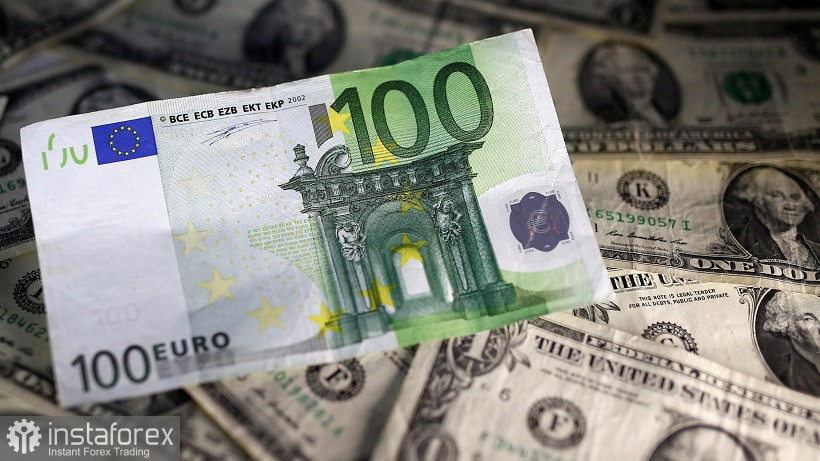The last trading week was marked by the weakening of the dollar and the growth of the European currency. If we take a look at the weekly EUR/USD chart, we will see that the bulls have regained the positions they lost the week before last. Between May 9 and May 13, the pair fell by more than 200 pips, while between May 16 and 20 it rose by almost 250 pips, if highs and lows are taken into account.

At the same time, it cannot be said that the EUR/USD bulls were able to reverse the downward trend: in this case, we can talk about a large-scale correction after the bears failed to overcome the support level of 1.0340. The week before last, bears hit a new multi-year low at 1.0349, but took profits almost immediately, not risking short positions at those lows. This week, the bears repeated their attempt to storm the 3rd figure, but also failed to settle in this price area. This time the bulls turned out to be bolder: they seized the initiative and settled on the border of 4 and 5 figures. By the end of the five-day trading period, the EUR/USD bulls strengthened their positions, but failed to settle in the area of the 6th figure. As a result, the "total score" for the last two weeks is 1:1. Bears lost control and failed to settle below 1.0400, while bulls failed to move above the 1.0600 target in two weeks, although they repeatedly approached the 6th price level. I believe that next week the scales will tip in one direction or another: either the bears will return the pair to the area of the 4th figure, or the bulls will continue their corrective rise to their "price ceiling", i.e. to 1.0760 (Tenkan-sen line on the daily chart).
The push-pull that we have seen over the past two weeks is due, in my opinion, to two reasons. Firstly, the market won back the hawkish comments of the Federal Reserve representatives, and secondly, traders finally heard tougher notes from the members of the European Central Bank.
The representatives of the Fed, who have spoken over the past ten days, on the one hand, confirmed the hawkish attitude of the central bank, but on the other hand, they did not tighten their rhetoric. For example, New York Fed Chief John Williams actually announced a 50 basis point rate hike at least two meetings in June and July. A similar position was voiced by other members of the Fed, who also have a vote in the Committee this year - in particular, James Bullard and Loretta Mester.
The dollar reflexively reacted to these messages, temporarily strengthening its position in tandem with the euro. However, the EUR/USD bears were unable to organize a new offensive in the area of 5-year price lows only on this basis. Suppose if the members of the Fed were talking about a 75-point increase in a more constructive way, then the result of the "verbal pumping" would be completely different. But so far, the majority of Fed representatives reject this idea, at the same time declaring that a 50-point move is optimal.
In other words, the Fed's hawkish attitude allows EUR/USD bears to stay in the 4-5 figure area, while holding back counterattacks by the bulls. But the lack of "ultra-hawkish" fuse (which would be expressed in the implementation of a 75-point rate hike) leads to shackling bears. Traders do not dare to re-storm the third figure without a corresponding informational background, and therefore take profits when approaching the support level of 1.0450.
The European currency, meanwhile, perked up this week, amid growing hawkish sentiment from the ECB. Several representatives of the ECB spoke in favor of an early increase in interest rates. Just yesterday, ECB Governing Council member Joachim Nagel (Chairman of the Bundesbank) said that "negative interest rates are becoming a thing of the past." But at the same time, he refused to directly answer the question of whether the central bank is ready to support a 50-point increase at the July meeting. The head of the Bank of France, Francois Villeroy de Galo, also spoke in favor of an early rate increase, but also did not specify by what amount. A similar position was voiced by other representatives of the ECB, in particular, Madis Muller and Martins Kazaks. They expect an increase in interest rates following the results of the July meeting. The most decisive position was taken by the chairman of the central bank of the Netherlands, Klaas Knot, who said that a 50-point rate hike "cannot be ruled out." However, the rest of his colleagues, including ECB President Christine Lagarde, are in no hurry to voice the specific amount by which they are ready to raise rates. Although almost all members of the ECB in one way or another support the very idea of raising, focusing on July.
Thus, the EUR/USD pair corrected due to a temporary weakening of the greenback, as well as due to the strengthening of the hawkish mood of the ECB. However, bulls failed to settle above 1.0600 over the past two weeks, although this is a prerequisite for further price growth as part of a larger corrective rollback. This suggests that traders doubt the prospects for the upward scenario. When approaching the sixth figure, they take profit (in the same way as when approaching the third price level). Most likely, in the medium term, the pair will trade in the range of 1.0450-1.0600, starting from the boundaries of this price range. Therefore, when the upward momentum fades near the borders of the sixth figure, then you can consider short positions while aiming for 1.0500 and 1.0450.
 English
English 
 Русский
Русский Bahasa Indonesia
Bahasa Indonesia Bahasa Malay
Bahasa Malay ไทย
ไทย Español
Español Deutsch
Deutsch Български
Български Français
Français Tiếng Việt
Tiếng Việt 中文
中文 বাংলা
বাংলা हिन्दी
हिन्दी Čeština
Čeština Українська
Українська Română
Română

